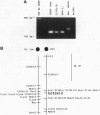Abstract
Guinea pig eotaxin is a recently described member of the Cys-Cys family of chemokines and is involved in a guinea pig model of asthma. To determine whether eotaxin is a distinctive member of this family and to understand its physiologic role, we have cloned the mouse eotaxin gene and determined its structure and aspects of its biologic function. The sequence relationship between the mouse and guinea pig genes indicates that eotaxin is indeed a distinct member of the chemokine family. Moreover, murine eotaxin maps to a region of mouse chromosome 11 that encodes other Cys-Cys chemokines. In addition, recombinant murine eotaxin protein has direct chemoattractant properties for eosinophils. The eotaxin gene is widely (but not ubiquitously) expressed in normal mice and is strongly induced in cultured endothelial cells in response to interferon gamma. Eotaxin is also induced locally in response to the transplantation of interleukin 4-secreting tumor cells, indicating that it likely contributes to the eosinophil recruitment and antitumor effect of interleukin 4. Such responses suggest that eotaxin may be involved in multiple inflammatory states.
Full text
PDF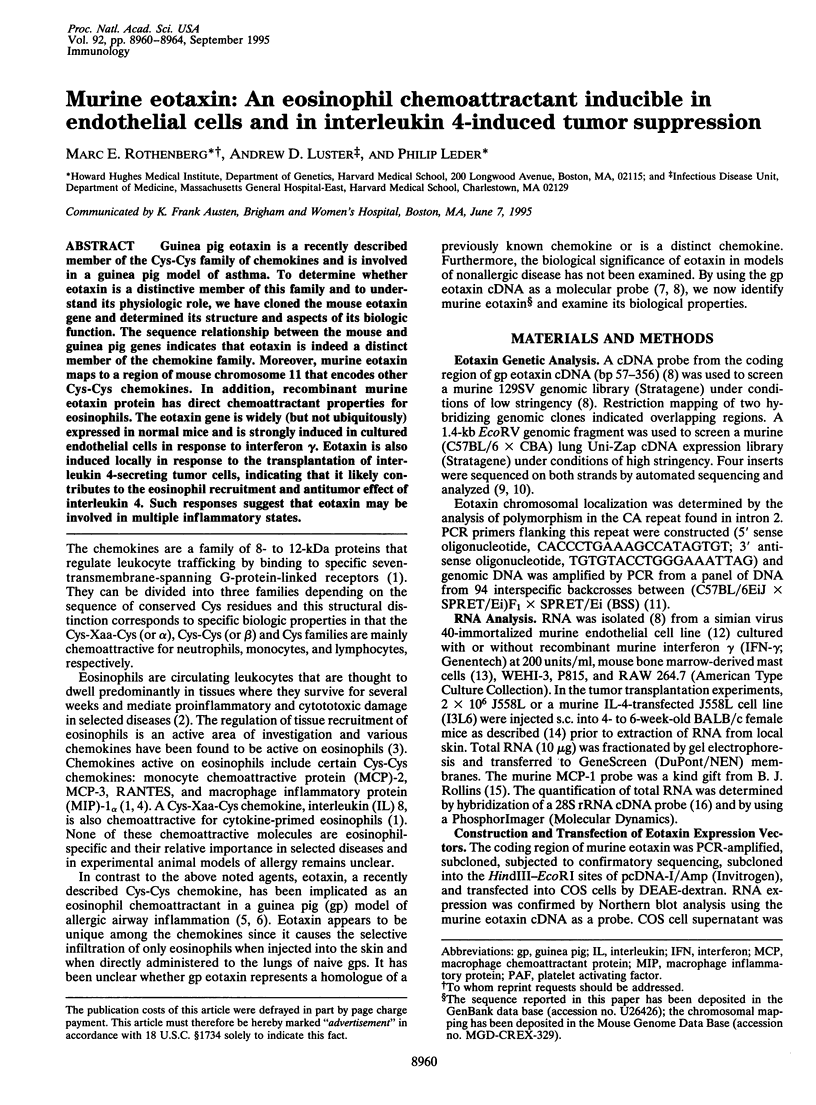
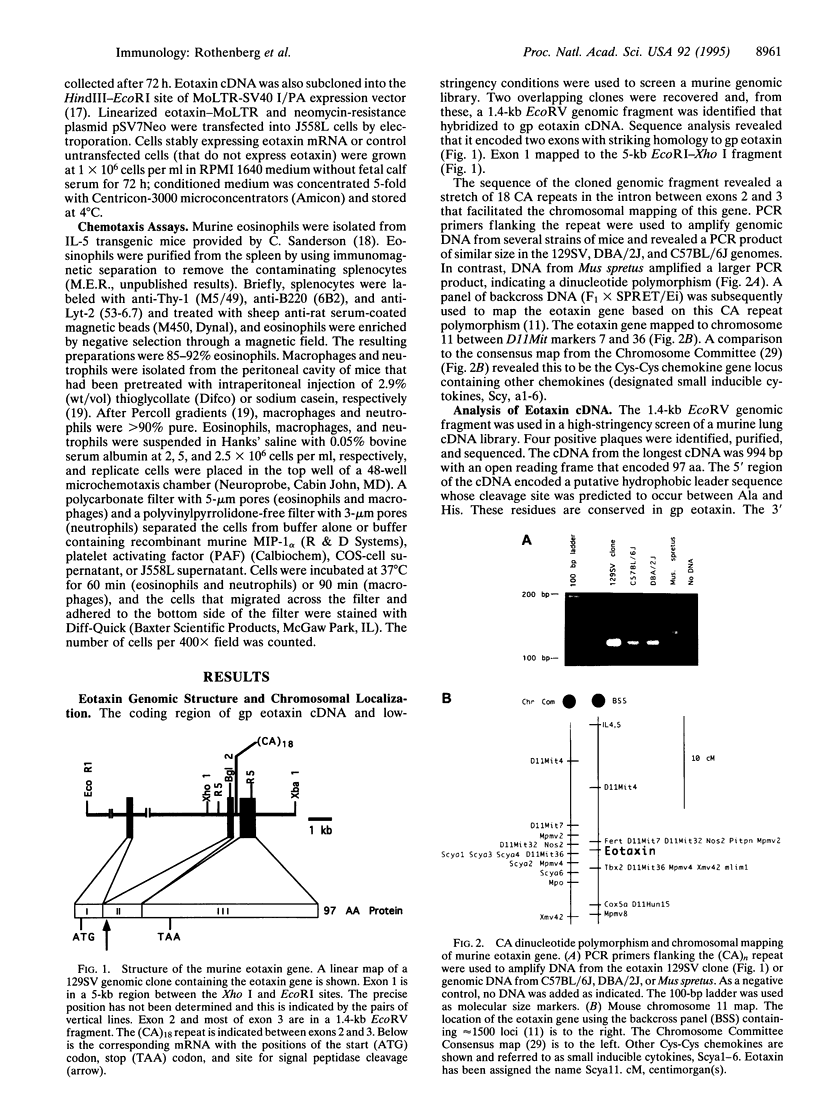
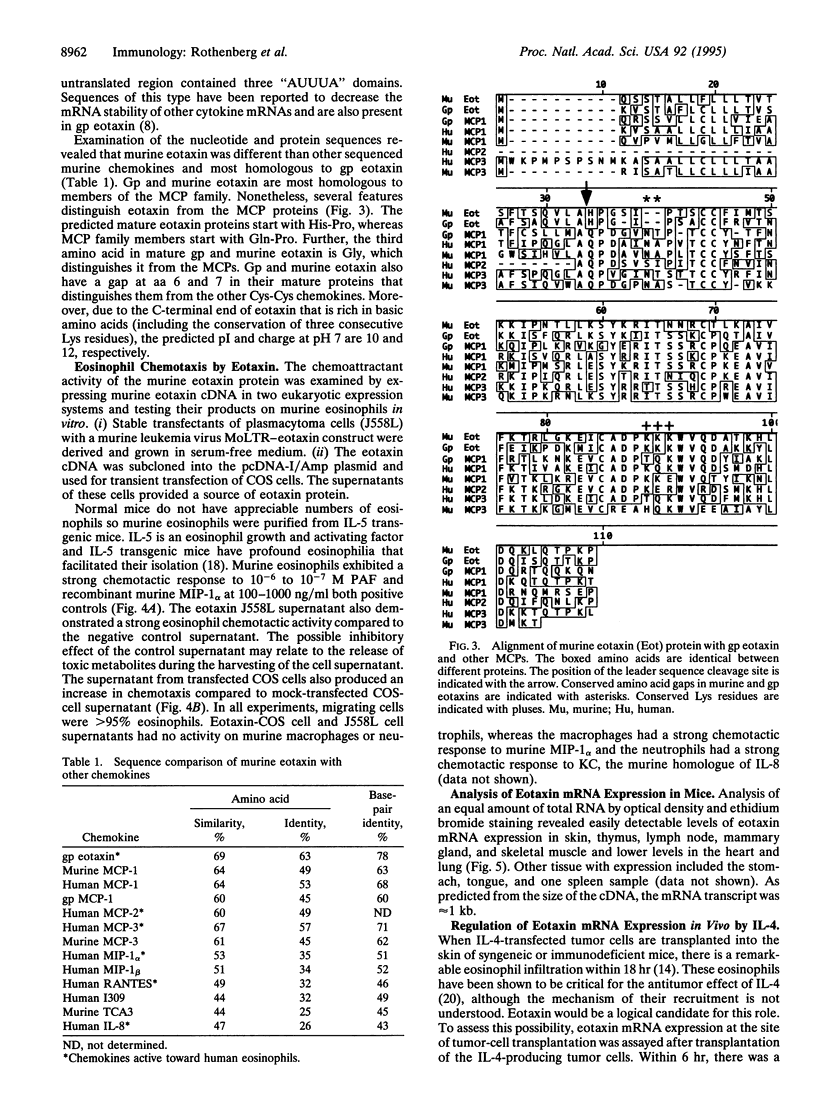
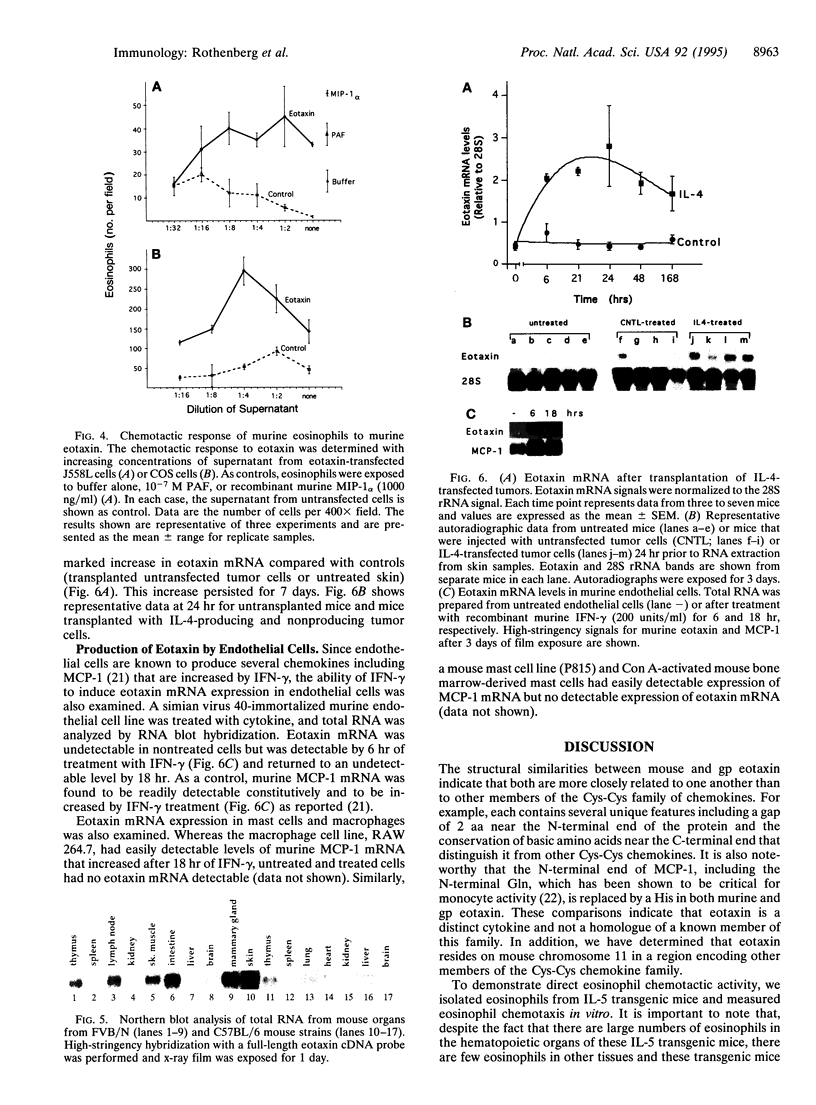
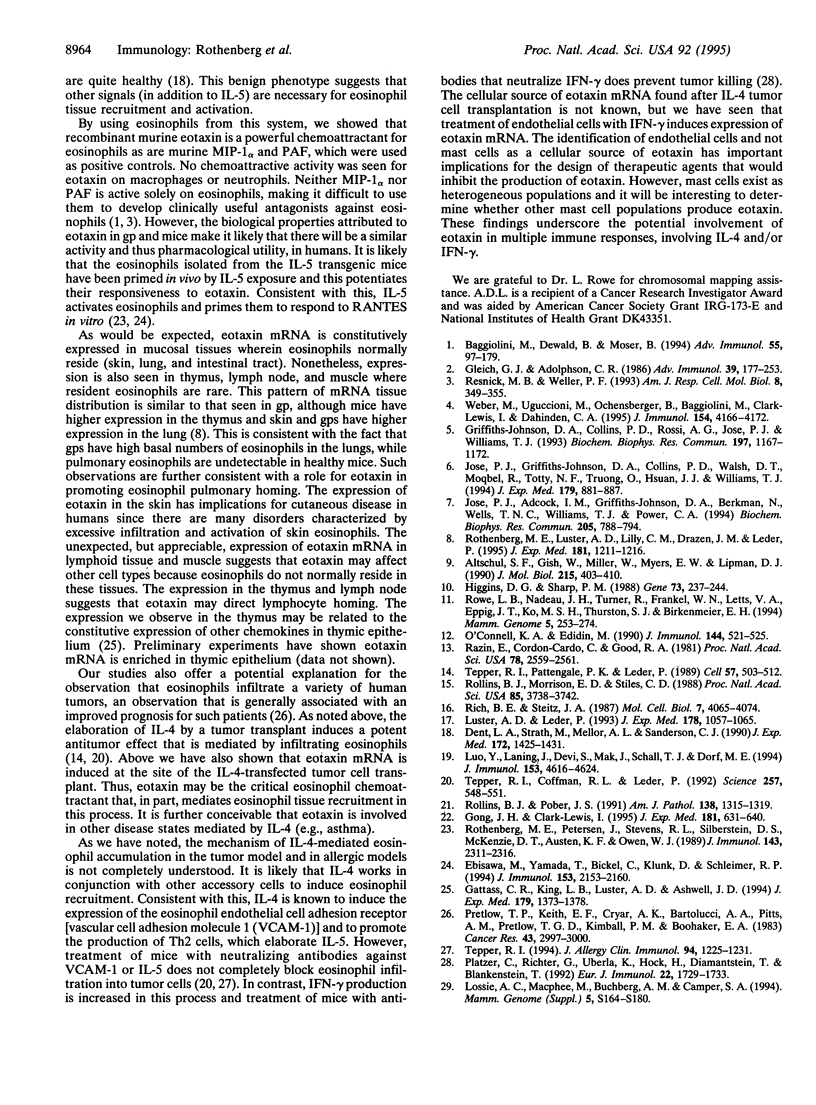
Images in this article
Selected References
These references are in PubMed. This may not be the complete list of references from this article.
- Altschul S. F., Gish W., Miller W., Myers E. W., Lipman D. J. Basic local alignment search tool. J Mol Biol. 1990 Oct 5;215(3):403–410. doi: 10.1016/S0022-2836(05)80360-2. [DOI] [PubMed] [Google Scholar]
- Baggiolini M., Dewald B., Moser B. Interleukin-8 and related chemotactic cytokines--CXC and CC chemokines. Adv Immunol. 1994;55:97–179. [PubMed] [Google Scholar]
- Dent L. A., Strath M., Mellor A. L., Sanderson C. J. Eosinophilia in transgenic mice expressing interleukin 5. J Exp Med. 1990 Nov 1;172(5):1425–1431. doi: 10.1084/jem.172.5.1425. [DOI] [PMC free article] [PubMed] [Google Scholar]
- Ebisawa M., Yamada T., Bickel C., Klunk D., Schleimer R. P. Eosinophil transendothelial migration induced by cytokines. III. Effect of the chemokine RANTES. J Immunol. 1994 Sep 1;153(5):2153–2160. [PubMed] [Google Scholar]
- Gattass C. R., King L. B., Luster A. D., Ashwell J. D. Constitutive expression of interferon gamma-inducible protein 10 in lymphoid organs and inducible expression in T cells and thymocytes. J Exp Med. 1994 Apr 1;179(4):1373–1378. doi: 10.1084/jem.179.4.1373. [DOI] [PMC free article] [PubMed] [Google Scholar]
- Gleich G. J., Adolphson C. R. The eosinophilic leukocyte: structure and function. Adv Immunol. 1986;39:177–253. doi: 10.1016/s0065-2776(08)60351-x. [DOI] [PubMed] [Google Scholar]
- Gong J. H., Clark-Lewis I. Antagonists of monocyte chemoattractant protein 1 identified by modification of functionally critical NH2-terminal residues. J Exp Med. 1995 Feb 1;181(2):631–640. doi: 10.1084/jem.181.2.631. [DOI] [PMC free article] [PubMed] [Google Scholar]
- Griffiths-Johnson D. A., Collins P. D., Rossi A. G., Jose P. J., Williams T. J. The chemokine, eotaxin, activates guinea-pig eosinophils in vitro and causes their accumulation into the lung in vivo. Biochem Biophys Res Commun. 1993 Dec 30;197(3):1167–1172. doi: 10.1006/bbrc.1993.2599. [DOI] [PubMed] [Google Scholar]
- Higgins D. G., Sharp P. M. CLUSTAL: a package for performing multiple sequence alignment on a microcomputer. Gene. 1988 Dec 15;73(1):237–244. doi: 10.1016/0378-1119(88)90330-7. [DOI] [PubMed] [Google Scholar]
- Jose P. J., Adcock I. M., Griffiths-Johnson D. A., Berkman N., Wells T. N., Williams T. J., Power C. A. Eotaxin: cloning of an eosinophil chemoattractant cytokine and increased mRNA expression in allergen-challenged guinea-pig lungs. Biochem Biophys Res Commun. 1994 Nov 30;205(1):788–794. doi: 10.1006/bbrc.1994.2734. [DOI] [PubMed] [Google Scholar]
- Jose P. J., Griffiths-Johnson D. A., Collins P. D., Walsh D. T., Moqbel R., Totty N. F., Truong O., Hsuan J. J., Williams T. J. Eotaxin: a potent eosinophil chemoattractant cytokine detected in a guinea pig model of allergic airways inflammation. J Exp Med. 1994 Mar 1;179(3):881–887. doi: 10.1084/jem.179.3.881. [DOI] [PMC free article] [PubMed] [Google Scholar]
- Lossie A. C., MacPhee M., Buchberg A. M., Camper S. A. Mouse chromosome 11. Mamm Genome. 1994;5(Spec No):S164–S180. [PubMed] [Google Scholar]
- Luo Y., Laning J., Devi S., Mak J., Schall T. J., Dorf M. E. Biologic activities of the murine beta-chemokine TCA3. J Immunol. 1994 Nov 15;153(10):4616–4624. [PubMed] [Google Scholar]
- Luster A. D., Leder P. IP-10, a -C-X-C- chemokine, elicits a potent thymus-dependent antitumor response in vivo. J Exp Med. 1993 Sep 1;178(3):1057–1065. doi: 10.1084/jem.178.3.1057. [DOI] [PMC free article] [PubMed] [Google Scholar]
- O'Connell K. A., Edidin M. A mouse lymphoid endothelial cell line immortalized by simian virus 40 binds lymphocytes and retains functional characteristics of normal endothelial cells. J Immunol. 1990 Jan 15;144(2):521–525. [PubMed] [Google Scholar]
- Platzer C., Richter G., Uberla K., Hock H., Diamantstein T., Blankenstein T. Interleukin-4-mediated tumor suppression in nude mice involves interferon-gamma. Eur J Immunol. 1992 Jul;22(7):1729–1733. doi: 10.1002/eji.1830220710. [DOI] [PubMed] [Google Scholar]
- Pretlow T. P., Keith E. F., Cryar A. K., Bartolucci A. A., Pitts A. M., Pretlow T. G., 2nd, Kimball P. M., Boohaker E. A. Eosinophil infiltration of human colonic carcinomas as a prognostic indicator. Cancer Res. 1983 Jun;43(6):2997–3000. [PubMed] [Google Scholar]
- Razin E., Cordon-Cardo C., Good R. A. Growth of a pure population of mouse mast cells in vitro with conditioned medium derived from concanavalin A-stimulated splenocytes. Proc Natl Acad Sci U S A. 1981 Apr;78(4):2559–2561. doi: 10.1073/pnas.78.4.2559. [DOI] [PMC free article] [PubMed] [Google Scholar]
- Resnick M. B., Weller P. F. Mechanisms of eosinophil recruitment. Am J Respir Cell Mol Biol. 1993 Apr;8(4):349–355. doi: 10.1165/ajrcmb/8.4.349. [DOI] [PubMed] [Google Scholar]
- Rich B. E., Steitz J. A. Human acidic ribosomal phosphoproteins P0, P1, and P2: analysis of cDNA clones, in vitro synthesis, and assembly. Mol Cell Biol. 1987 Nov;7(11):4065–4074. doi: 10.1128/mcb.7.11.4065. [DOI] [PMC free article] [PubMed] [Google Scholar]
- Rollins B. J., Morrison E. D., Stiles C. D. Cloning and expression of JE, a gene inducible by platelet-derived growth factor and whose product has cytokine-like properties. Proc Natl Acad Sci U S A. 1988 Jun;85(11):3738–3742. doi: 10.1073/pnas.85.11.3738. [DOI] [PMC free article] [PubMed] [Google Scholar]
- Rollins B. J., Pober J. S. Interleukin-4 induces the synthesis and secretion of MCP-1/JE by human endothelial cells. Am J Pathol. 1991 Jun;138(6):1315–1319. [PMC free article] [PubMed] [Google Scholar]
- Rothenberg M. E., Luster A. D., Lilly C. M., Drazen J. M., Leder P. Constitutive and allergen-induced expression of eotaxin mRNA in the guinea pig lung. J Exp Med. 1995 Mar 1;181(3):1211–1216. doi: 10.1084/jem.181.3.1211. [DOI] [PMC free article] [PubMed] [Google Scholar]
- Rothenberg M. E., Petersen J., Stevens R. L., Silberstein D. S., McKenzie D. T., Austen K. F., Owen W. F., Jr IL-5-dependent conversion of normodense human eosinophils to the hypodense phenotype uses 3T3 fibroblasts for enhanced viability, accelerated hypodensity, and sustained antibody-dependent cytotoxicity. J Immunol. 1989 Oct 1;143(7):2311–2316. [PubMed] [Google Scholar]
- Rowe L. B., Nadeau J. H., Turner R., Frankel W. N., Letts V. A., Eppig J. T., Ko M. S., Thurston S. J., Birkenmeier E. H. Maps from two interspecific backcross DNA panels available as a community genetic mapping resource. Mamm Genome. 1994 May;5(5):253–274. doi: 10.1007/BF00389540. [DOI] [PubMed] [Google Scholar]
- Tepper R. I., Coffman R. L., Leder P. An eosinophil-dependent mechanism for the antitumor effect of interleukin-4. Science. 1992 Jul 24;257(5069):548–551. doi: 10.1126/science.1636093. [DOI] [PubMed] [Google Scholar]
- Tepper R. I. The eosinophil-mediated antitumor activity of interleukin-4. J Allergy Clin Immunol. 1994 Dec;94(6 Pt 2):1225–1231. doi: 10.1016/0091-6749(94)90336-0. [DOI] [PubMed] [Google Scholar]
- Weber M., Uguccioni M., Ochensberger B., Baggiolini M., Clark-Lewis I., Dahinden C. A. Monocyte chemotactic protein MCP-2 activates human basophil and eosinophil leukocytes similar to MCP-3. J Immunol. 1995 Apr 15;154(8):4166–4172. [PubMed] [Google Scholar]



